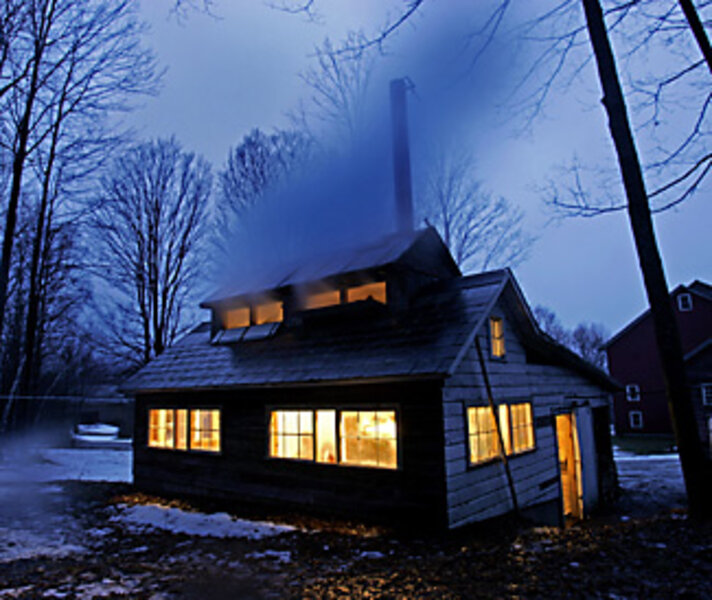Economic sweet spot: making maple syrup
Loading...
Keith Dufresne says the sugaring weather is so good, he's on track to produce a record amount of maple syrup this season.
Frigid nights and warmer days are spurring maple trees across his 200-acre farm in western Massachusetts to pump out the sticky sap that he turns into syrup.
"I wonder when it's going to stop," says Mr. Dufresne, a fourth-generation sugarmaker, who is operating on about three hours of sleep a night. "It's driving us nuts."
It may represent only a tiny part of America's generally souring economy, but sugarmakers in southern New England are reporting a sweet turnaround. One year after the lowest syrup-producing season since 2001, demand is at a record high even as the price rises. Experts caution against assuming syrup producers will strike it rich: Production remains dependent on the weather, and increased fuel costs will offset profits. For now, though, the weather is perfect.
Rick Marsh, president of the Vermont Maple Sugar Makers' Association, says his sugar bush – a collection of trees for harvesting maple syrup – near Burlington has already produced two-thirds of the expected crop. "This is abnormal," he says. "I'm hearing that downstate, [as well as] Massachusetts, Connecticut, and Ohio are doing quite well."
The season hasn't yet been as kind to sugarmakers to the north and those in higher elevations where it's been too cold. Optimum sap flow requires freezing temperatures at night and bright sunshine and temperatures in the 40s during the day, says Brian Chabot, a Cornell University scientist.
Mr. Marsh says sugarmakers won't meet demand for the product, which has skyrocketed domestically and internationally, especially in Asia and Russia. "We're growing the market. Now we just need to grow production," he says.
Partly because of maple syrup's low-fat content and partly because of organic food's popularity, sugarmakers have been able to find new outlets beyond the familiar gallon jugs and plastic squeeze bottles found on store shelves. Dufresne sells syrup to several granola companies, a brewery, and breadmakers, all organizations that weren't interested in his crop five years ago.
"It's part of the interest in sustainable projects and it's good for carbon sequestering" because the trees are not cut down, says Marcia Maynard, a Cabot, Vt., organic sugarmaker, adding that her production is down this year but she believes it can rebound.
High demand for the sweet stuff has reduced millions of pounds of syrup stockpiles and driven up the price, says Larry Myott, executive secretary of the International Maple Syrup Institute. "Last year was not a blockbuster year. And the surplus has disappeared over the last five years," he says. "As of March first, it was virtually gone."
Prices have "gone up rapidly and quite drastically in the past few years," Mr. Myott says. Nadeen Lyndaker, a sugarmaker in Croghan, N.Y., raised her prices from $30 a gallon to $35 this season. Marsh is charging in the mid- to high-$40 range, and prices have increased by 5 percent in the sugar bushes in New York where Professor Chabot works.
Sugarmakers' glee is tempered by a few factors. Bad weather could still derail the run: An unseasonably cold winter with a lot of snow has left Ms. Maynard and sugarmakers near her with about half of the sap they normally have by April 1.
Increased fuel costs have also hit sugarmakers. Many deliver syrup directly to customers, and use fuel-powered machines to evaporate water from sap.
With oil prices hovering around $4 a gallon and three gallons of oil needed to produce a gallon of syrup, "it costs $12 just to produce a gallon of syrup," Marsh says.
Farmers have also seen as much as a 30 percent hike in the costs of plastics used for collecting and packaging syrup because some are made with petroleum, Myott says.
Even a weaker dollar won't lure many big customers away from Canada, which produces about 80 percent of the world's maple syrup. Canadian producers work through a federation that facilitates syrup distribution to large retailers, Chabot says. By contrast, US sugarmakers often run small, independent operations. "Few US facilities could do a BJ's or a Sam's Club," he says.
Sugarmakers take it all with aplomb. "It's the glow in your heart that makes you go out in 32 degrees, in rain, and frozen snow," Dufresne says, to produce the sweet golden syrup that brings a smile to just about everyone's face.






